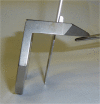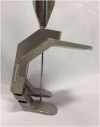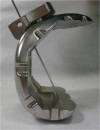Primary posterior stabilized total knee arthroplasty: analysis of different instrumentation
- PMID: 25037275
- PMCID: PMC4223625
- DOI: 10.1186/s13018-014-0054-y
Primary posterior stabilized total knee arthroplasty: analysis of different instrumentation
Abstract
Background: Intercondylar femoral bone removal during posterior stabilized (PS) total knee arthroplasty (TKA) makes many cruciate substituting implant designs less appealing than cruciate retaining implants. Bone stock conservation is considered fundamental in the prevision of future revision surgeries. The purpose of this study was to compare the quantity of intercondylar bone removable during PS housing preparation using three contemporary PS TKA instrumentations.
Method: We compared different box cutting jigs which were utilized for the PS housing of three popular PS knee prostheses. The bone removal area from every PS box cutting jig was three-dimensionally measured.
Results: Independently from the implant size, the cutting jig for a specific PS TKA always resected significantly less bone than the others: this difference was statistically significant, especially for small- to medium-sized total knee femoral components.
Conclusion: This study does not establish a clinical relevance of removing more or less bone at primary TKA, but suggests that if a PS design is indicated, it is preferable to select a model which possibly resects less distal femoral bone.
Figures





References
-
- Wragg R, Khan RJZ, Damasena ITW. A comparison of bone loss at total knee replacement: posterior stabilized versus cruciate retaining. J Orthopaedics. 2012;9(1):e1.
-
- Becher C, Heyse TJ, Kron N, Ostermeier S, Hurschler C, Schofer MD, Fuchs-Winkelmann S, Tibesku CO. Posterior stabilized TKA reduce patellofemoral contact pressure compared with cruciate retaining TKA in vitro. Knee Surg Sports Traumatol Arthrosc. 2009;17(10):1159–1165. doi: 10.1007/s00167-009-0768-2. - DOI - PubMed
-
- Puloski SK, McCalden RW, MacDonald SJ, Rorabeck CH, Bourne RB. Tibial post wear in posterior stabilized total knee arthroplasty. An unrecognized source of polyethylene debris. J Bone Joint Surg Am. 2001;83-A(3):390–397. - PubMed
Publication types
MeSH terms
LinkOut - more resources
Full Text Sources
Other Literature Sources
Medical

